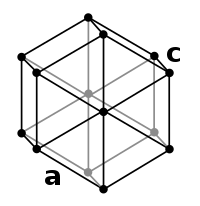
Photo from wikipedia
The compounds Fujikurin A, B, and D, recently isolated from Fusarium fujikuroi, possess intramolecular low-barrier hydrogen bonds (LBHBs), which are hydrogen bonds with a very low-energy barrier for proton transfer.… Click to show full abstract
The compounds Fujikurin A, B, and D, recently isolated from Fusarium fujikuroi, possess intramolecular low-barrier hydrogen bonds (LBHBs), which are hydrogen bonds with a very low-energy barrier for proton transfer. The isolated compounds have a hydrogen-bonded proton that appears to rapidly switch between two equilibrium states via a transition state (TS). To understand the characteristics of these intramolecular LBHBs in detail, we performed path integral molecular dynamics (PIMD) simulations, which can consider nuclear quantum effects (NQEs) under a finite temperature. The PIMD simulations predicted that the NQE completely washed out the energy barrier for the proton transfer reaction. Consequently, a single-well shape emerged in the results, along with the effective free-energy potential surface for the hydrogen-bonded proton distribution. Thus, we conclude that the hydrogen-bonded proton in Fujikurin does not in fact transfer between two equilibrium structures but widely delocalizes around the global minimum structure involving the TS region.
Journal Title: ACS Omega
Year Published: 2022
Link to full text (if available)
Share on Social Media: Sign Up to like & get
recommendations!